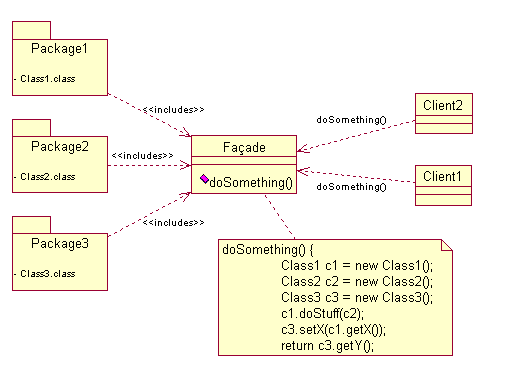From Wikipedia, the free encyclopedia
The facade pattern is a software engineering design pattern commonly used with Object-oriented programming. The name is by analogy to an architectural facade.A facade is an object that provides a simplified interface to a larger body of code, such as a class library. A facade can:
- make a software library easier to use, understand and test, since the facade has convenient methods for common tasks;
- make code that uses the library more readable, for the same reason;
- reduce dependencies of outside code on the inner workings of a library, since most code uses the facade, thus allowing more flexibility in developing the system;
- wrap a poorly-designed collection of APIs with a single well-designed API (as per task needs).
Structure

- Facade
- The facade class abstracts Packages 1, 2, and 3 from the rest of the application.
- Clients
- The objects using the Facade Pattern to access resources from the Packages.
Example
/* Complex parts */ class CPU { public void freeze() { ... } public void jump(long position) { ... } public void execute() { ... } } class Memory { public void load(long position, byte[] data) { ... } } class HardDrive { public byte[] read(long lba, int size) { ... } } /* Facade */ class Computer { private CPU cpu; private Memory memory; private HardDrive hardDrive; public Computer() { this.cpu = new CPU(); this.memory = new Memory(); this.hardDrive = new HardDrive(); } public void startComputer() { cpu.freeze(); memory.load(BOOT_ADDRESS, hardDrive.read(BOOT_SECTOR, SECTOR_SIZE)); cpu.jump(BOOT_ADDRESS); cpu.execute(); } } /* Client */ class You { public static void main(String[] args) { Computer facade = new Computer(); facade.startComputer(); } }
No comments:
Post a Comment